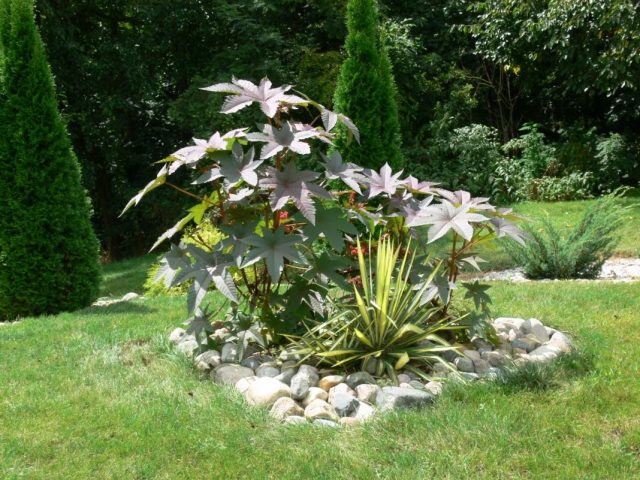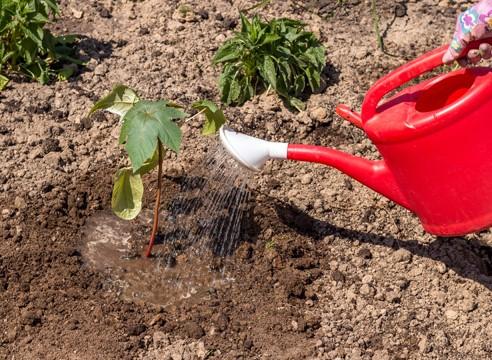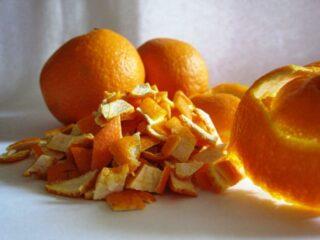Content
Castor bean is a plant of the Euphorbiaceae family. It is used as an oilseed and has healing properties. Its leaves look quite original and unusual, so, in principle, it can be used by gardeners as a decorative plant. Planting and caring for castor beans in open ground is not very difficult, but it is rarely found in flower beds. And there are objective reasons for this.
Is it possible to plant castor beans in the country?
Castor bean is a plant with an exotic “appearance”. When planted in a flowerbed in open ground, it will definitely not get lost thanks to the stems of a rich raspberry-burgundy shade and large leaves of an original shape. Flowers and “prickly” fruits add decorativeness to it. However, after studying the description, many gardeners refuse to plant in open ground.

Despite its tropical origin, castor beans can be cultivated in Russian regions with a temperate climate.
The fact is that all parts of the plant contain the protein ricin and the alkaloid ricinin.The minimum dose (about 500 mcg) taken orally provides the body with severe intoxication. It is manifested by attacks of vomiting, enteritis, colic and internal bleeding in the abdominal cavity. Without medical care, death occurs within 5-7 days.
When to plant castor beans with seeds in open ground
Gardeners practice both growing castor seedlings and planting seeds directly in open ground. The second option is more popular, because it requires much less time and effort. When planting seeds in open ground, you must wait until the likelihood of return frosts in the spring is minimized.

This is a tropical plant; the seedlings will not survive even short-term exposure to negative temperatures.
The specific time for sowing castor beans in open ground is determined taking into account local climatic conditions. In the southern Russian regions this is approximately mid-April, in the middle zone - the last days of this month or the beginning of May. In more severe climatic conditions you have to wait until mid-May.
Planting castor beans in open ground
Planting castor beans in open ground is a simple procedure, which is clear from its step-by-step description. However, in order for it to show its decorativeness to the maximum and develop normally, it is necessary to take into account its few “requirements” for the planting site, as well as carry out the necessary preparation before sowing in open ground.
Selecting a location
Castor bean is a crop characterized by very high growth rates.Even in a temperate climate, it stretches 1.5-2 m in height over a season, forming a “bush” with a diameter of up to 1 m. This must be taken into account when planting seeds in open ground, providing enough space for future plants. Between adjacent specimens and any obstacles leave 0.8-1.5 m.
Not knowing how to properly sow castor beans in open ground, they choose a site where the soil meets the following conditions:
- looseness and “lightness”, ensuring normal air access to the roots;
- ability to retain moisture;
- neutral or slightly acidic pH (5.0-6.5);
- average level of fertility.
It would be most correct to plant castor beans in open ground in loam or sandy loam. In principle, it is able to adapt to an acidified, alkaline, low-nutrient substrate, but under such conditions it noticeably loses its decorative properties. In addition, when planting in the ground in an open place, it is necessary to provide it with support - the stems seem powerful, but in fact they are quite fragile and break easily.

As a tropical plant, castor oil does not tolerate constant cold drafts and sharp gusts of wind.
When deciding how and where to properly plant castor beans in open ground, you need to take into account that in a place well lit by the sun, castor bean stems retain a bright crimson-raspberry hue. When there is a lack of light, they darken to inky purple.
Soil preparation
In the fall, the area chosen for planting castor beans in open ground is dug up and cleared of plant and other debris.During the process, natural organic matter (humus or rotted compost) is added, as well as complex fertilizer.
In the spring, about 2-3 days before sowing castor beans in open ground, the soil is well loosened and leveled. To make the substrate warm up faster, you can cover the flowerbed with black polyethylene.
Seed preparation
Some gardeners begin preparing seeds for planting in open ground with stratification. They are kept in the refrigerator for 8-10 weeks, mixed with wet sand or peat. However, there is no fundamental need for such “imitation”; under natural conditions they do not overwinter in frozen soil.
The shell of castor bean seeds is hard. Therefore, before planting in open ground, they need scarification.

The shell is slightly “damaged” with a nail file, file or sandpaper to “help” the seeds germinate
Also, germination is positively affected by soaking seeds before planting in a solution of any biostimulant for 4-6 hours. Both store-bought drugs and folk remedies are suitable.
How to plant castor beans correctly
Before planting in open ground, the soil is moderately moistened. The seeds are sown to a depth of about 2 cm. They are quite large, so it is easy to immediately plant them “individually” or 2-3 pieces each, subsequently leaving one of the most powerful seedlings.

Shoots appear unevenly, within 2-4 weeks
Seeds are sown in open ground immediately in a permanent place. After planting, castor beans quickly form a taproot, which will inevitably be damaged when transferred to another area.
Caring for castor beans in open ground
Care after planting in open ground is limited to standard measures. In terms of agricultural cultivation technology, castor beans are practically “problem-free”; diseases and other difficulties during its cultivation are quite rare.
Watering
Like many tropical crops, castor oil is moisture-loving. The substrate in the flowerbed after planting it in open ground must be constantly maintained in a moderately moist state.
If it is not too warm outside, watering is carried out once every 3-5 days. In hot weather they switch to daily soil moistening.

Approximate watering rate – 10-15 liters of water per plant
Soil looseness and breathability are one of the main requirements for soil after planting. Therefore, the technology for growing castor beans includes recommendations for loosening the soil after each watering. If necessary, this activity is combined with weeding. An alternative could be mulching the soil: mulch prevents the rapid evaporation of moisture from the soil, the growth of weeds, and prevents it from “baking” into an airtight crust.
Top dressing
As for fertilizing, castor bean reacts very positively to natural organic matter. Such fertilizers contribute to its rapid growth, increased leaf size, and more abundant flowering.
The rules for growing the castor bean flower include fertilizing, starting in the 2-3 phase of the true leaf. At intervals of 15-20 days, castor beans are watered with infusions of cow manure, bird droppings, and “green tea” made from nettle leaves, dandelion or other weeds.
Store-bought complex fertilizers are used only twice per season - immediately before flowering and 7-10 days after it.They help to “support” the plant, which has spent a lot of effort, and promote the formation of fruits and the ripening of seeds.
Pests and diseases
Even when planted in open ground in unusual climatic conditions, castor beans rarely get sick. However, it is not completely immune from damage by pathogenic microflora. The experience of Russian gardeners shows that most often the plant is affected by the following diseases:
- Fusarium. The growth and development of castor beans stops, the leaves quickly turn yellow and wither.
Another sign of fusarium is purple spots on the stems, however, due to their specific color in castor beans, it is difficult to notice
- Microsporosis. The leaves become covered with brown spots, the tissues affected by the fungus quickly dry out and “fall off,” leaving holes.
The causative agent of microsporosis successfully overwinters in the soil even in severe frosts; the spores remain viable for 5-7 years
- Powdery mildew. A grayish or whitish coating forms on the leaves and stems, similar to spilled flour. Gradually it becomes denser and changes its hue to violet-gray, the tissues underneath dry out or rot, and die.
Powdery mildew is a “universal” disease that is dangerous for almost any garden crop in open ground.
Fungicides help cope with fungal diseases. Preliminary pruning is carried out, removing leaves, stems, and other areas of tissue affected by the pathogen. The solution is prepared according to the instructions in the manufacturer's instructions for the selected drug. It is also followed when determining the number of treatments and the intervals between them.
Pests on castor beans are an extremely atypical phenomenon. However, occasionally its plantings in the open ground are affected by tissue-feeding caterpillars of white butterflies, cutworms, and hawthorns. Almost any universal insecticides with a wide spectrum of action can help get rid of them.
Possible problems during cultivation
In addition to fairly rare cases of open-ground plantings becoming infected with diseases and pest attacks, problems when growing castor beans are most often associated with serious mistakes in caring for it. However, in most cases they are not “killer” for the plant - the wrong choice of planting site, untimely watering and fertilizing only lead to a slowdown in the rate of development and a decrease in the decorativeness of the plant.
The only exception is excessively frequent or abundant watering of plantings in open ground. It is impossible to grow castor beans in waterlogged soil: root rot develops quickly, which leads to the death of the plant.
Conclusion
Planting and caring for castor beans in open ground is a task that even a novice gardener can cope with. In order for the plant to feel comfortable, it requires a minimum of agrotechnical measures. Diseases and other problems during cultivation of castor beans are extremely rare. However, when planting it in open ground, you need to carefully weigh the pros and cons, taking into account the danger of the plant to human health and life.











